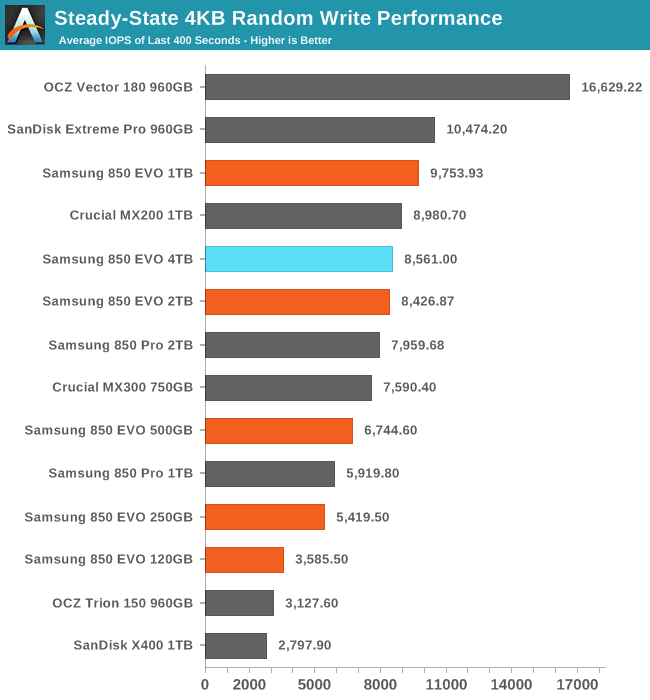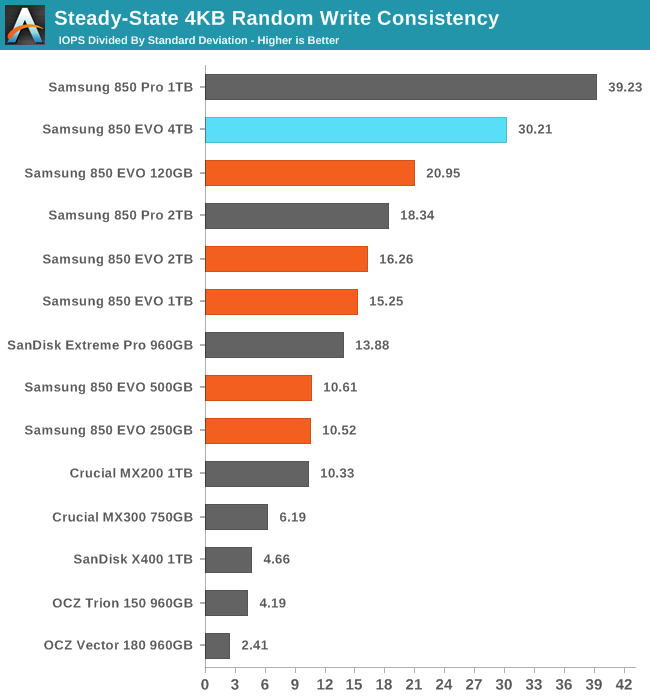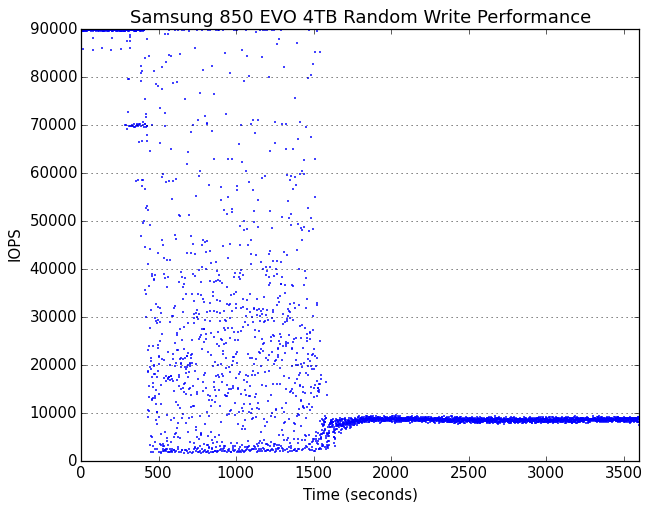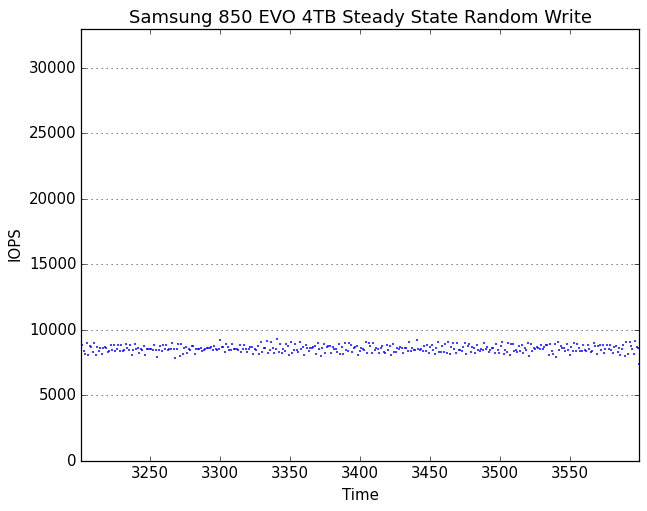The Samsung 850 EVO 4TB SSD Review
by Billy Tallis on July 11, 2016 10:00 AM ESTPerformance Consistency
Our performance consistency test explores the extent to which a drive can reliably sustain performance during a long-duration random write test. Specifications for consumer drives typically list peak performance numbers only attainable in ideal conditions. The performance in a worst-case scenario can be drastically different as over the course of a long test drives can run out of spare area, have to start performing garbage collection, and sometimes even reach power or thermal limits.
In addition to an overall decline in performance, a long test can show patterns in how performance varies on shorter timescales. Some drives will exhibit very little variance in performance from second to second, while others will show massive drops in performance during each garbage collection cycle but otherwise maintain good performance, and others show constantly wide variance. If a drive periodically slows to hard drive levels of performance, it may feel slow to use even if its overall average performance is very high.
To maximally stress the drive's controller and force it to perform garbage collection and wear leveling, this test conducts 4kB random writes with a queue depth of 32. The drive is filled before the start of the test, and the test duration is one hour. Any spare area will be exhausted early in the test and by the end of the hour even the largest drives with the most overprovisioning will have reached a steady state. We use the last 400 seconds of the test to score the drive both on steady-state average writes per second and on its performance divided by the standard deviation.

The 4TB 850 EVO restores a little bit of the performance that the 2TB lost relative to the 1TB, but Samsung's controller architecture is still clearly most comfortable at 1TB.

The consistency of the 2TB 850 EVO was only slightly better than the 1TB EVO, so it's surprising to see the 4TB model make such a large jump and come so close to the 1TB 850 Pro.
 |
|||||||||
| Default | |||||||||
| 25% Over-Provisioning | |||||||||
It is no surprise that a 4TB drive lasts so long before dropping out of peak performance: it has far more spare area to burn through than any ordinary consumer SATA SSD. The transition to steady state is uncharacteristically long and messy for a Samsung drive, and the performance lows during this period are disappointing. Once the drive has reached steady state, there's nothing to complain about.
 |
|||||||||
| Default | |||||||||
| 25% Over-Provisioning | |||||||||
There are no wild outliers from the 4TB 850 EVO's steady-state, and none of the longer-term drift in performance shown by the 1TB and 2TB 850 EVO and Pro models. With extra overprovisioning, the 4TB EVO carries on indefinitely with high and extremely steady performance.










145 Comments
View All Comments
Enigmatica - Monday, July 11, 2016 - link
Silh is right. My DAW system has 64GB of RAM and all of my samples are stored on a 400GB Intel PCIe NVME drive. I'm only a hobbyist but my set of samples is well into the 200GB range. Pros with all of the gear can easily break 1+ TBddriver - Monday, July 11, 2016 - link
Pros are actually invested in making music than obsessing with sample hoarding ;)NI KOMPLETE is 100 GB and it has pretty much everything you are ever going to need. Naturally, that means actual analog instruments. A lot of mediocre pseudo musicians obsess on hoarding what is not instrument samples but ready to use loops they can play and imagine they are doing music. The format of distribution of that stuff is as stupid as it is itself - since it is not really live performance and usually synthesized sound, it could just as well be distributed as midi + synthesizer presets, and take kilobytes rather than gigabytes - a million times less space...
smilingcrow - Monday, July 11, 2016 - link
Classic “I know what’s best for everybody” rant by someone that fails to understand the topic they are discussing.DPUser - Monday, July 11, 2016 - link
Smilingcrow is right on point here. While ddriver's words may accurately convey the mindset of a certain subset of "musicians" using computers, VI orchestrators and pro producers in many genres are not just using loops; describing these writers, arrangers, performers and engineers as "pseudo musicians" indicates a complete lack comprehension as to how these extremely talented folks work.And while is NI Komplete is wonderful, it is not (yet, if ever) the be all and end all. Incredible VIs are being developed every day by other developers, bringing new levels of fidelity and expression, making greater demands on system real-time performance and soaking up ever-increasing swaths of storage space.
Silh - Monday, July 11, 2016 - link
Have a look at some of the professional orchestral libraries. These are not loops, or instrument runs, but individual note samples, recorded with multiple articulations, velocity layers, different mic positions, etc. You're looking at at 300GB+ for, say, just the strings. VSL's full orchestra comes in about 1TB if you put everything together (and priced waaaaaaaay out of what I can afford).Daniel Egger - Monday, July 11, 2016 - link
RAW Photo editing is harmless: you import all data once and from then on it's mostly reading data. Even if you're a pro you'll have a hard time filling 4x64GB cards a day and you certainly won't sustain that throughout a year. So even if you believed in that segment-my-ass 300TB endurance figure you'll be using it for 3 or 4 years...ddriver - Monday, July 11, 2016 - link
Sure, editing involves mostly reading, you edit the photos then throw away the changes. But even then, photoshop will generate tens of gigabytes of temporary scratch files ;)smilingcrow - Monday, July 11, 2016 - link
A prosumer would be using a separate scratch disk with Photoshop though if they wanted top performance.Impulses - Monday, July 11, 2016 - link
Cheap(er) SATA drives for RAWs here (2x1TB EVO atm), SM951 for the apps and their libraries/scratch.mapesdhs - Wednesday, July 13, 2016 - link
Keep posting your sensible example config, I like that. 8)